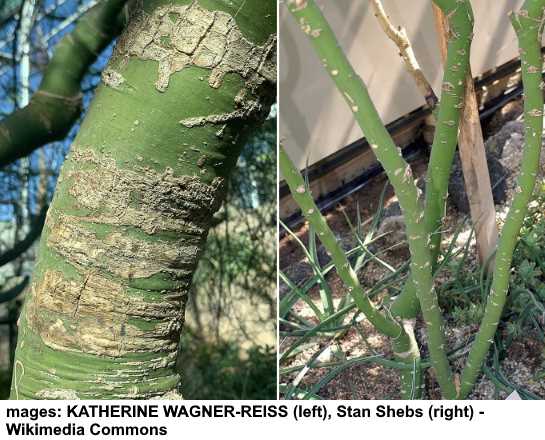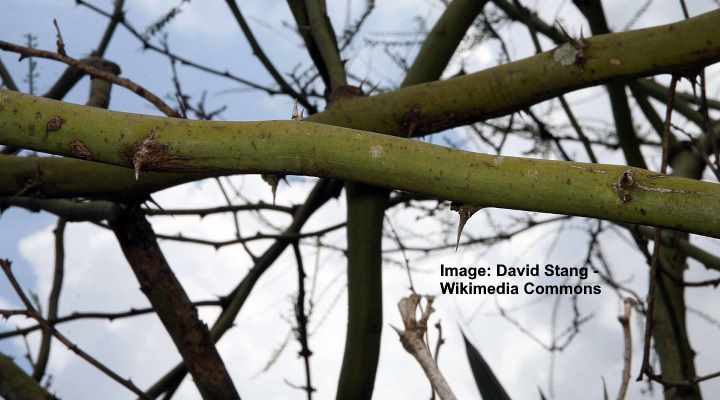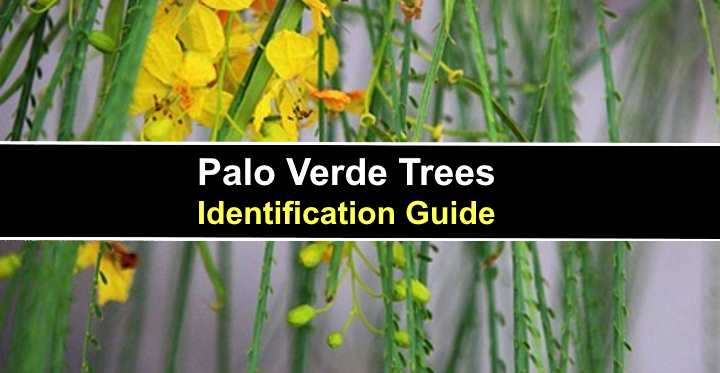Palo verde is a genus of tiny trees or large spiny shrubs with green branches, yellow pea-like flowers, brown seed pods, and tiny leaves that bloom briefly after rain. The desert tree of California, Arizona, and Mexico is the deciduous palo verde. It grows in hot, dry climates. During drought, the multi-stemmed decorative tree thrives, and during scorching weather, it grows in filtered shade.
Palo verde trees are native to North America and can be found in a variety of species. Foothill palo verde (Parkinsonia aculeata), blue palo verde (Parkinsonia florida), and desert museum palo verde (Parkinsonia x ‘Desert Museum’) are the most commonly seen varieties of palo verde trees.
The palo verde is one of the most drought-tolerant trees, and this article is a guide to it. The different species of this decorative desert tree can be identified using descriptions and photographs. Choosing a suitable species for your front or backyard is also covered in detail.
Palo Verde Trees
Palo verde (botanical name: Parkinsonia) is a little group of blooming trees found in hot regions. Between 16 and 40 feet (5 and 12 meters) tall, large palo verde bushes or small trees. The leaves of heat-tolerant trees drop when the earth is dry, making them a “dry season deciduous tree.”
The pea family, Fabaceae, includes Palo Verde trees. This thorny tree produces brown, leathery seed pods, just like all legumes do. The rough branches of this lovely tree are a feature. In USDA zones 8 through 11, Palo verde trees may be grown outdoors. Since 1954, the palo verde tree has been Arizona’s official state tree.
Palo verde trees’ yellowish-green pigments are commonly used to identify them in desert settings. While in bloom in the spring or autumn, several palo verde tree species are covered with tiny golden yellow flowers. The leaves of other species are yellowish-green.
Moreover, the tree’s distinctive green bark adds to its visual appeal when there are no flowers or leaves. In Spanish, the word Palo verde means “green stick.” The unique green trunk and limbs that distinguish the tree are called after this name. Jerusalem thorn, jelly bean tree, yellow palo verde, and foothill palo verde are some of the other names for this plant.
The palo verde’s growth habit is both unusual and remarkable. A palo verde survives in the desert environment without requiring additional water once it has established. The green bark can photosynthesize, and the small pinnate leaves help reduce moisture loss. Leaves wither and branches droop in addition to shedding during severe drought. The tree, however, will grow back and flourish when water becomes accessible.
Foothill or Yellow Palo Verde (Parkinsonia aculeata)
The lovely yellow palo verde is recognized as a upright branching tree with light-yellow spring-blooming flowers and is also known as the Mexican palo verde. On occasion, the tree may be covered in soft seed-filled pods. The foothill palo verde tree has distinctive green bark, like other palo verde trees. This compact tree lasts about 16 feet (5 meters) tall.
Blue Palo Verde Tree (Parkinsonia florida)
The gorgeous blue palo verde tree has gray-green leaves, little brilliant yellow flowers, and enormous, tough seed pods. It is a rapid-growing multi-stemmed tree. Photosynthesis is performed by the bluish branches and twigs of this decorative tree. The blue palo verde, which grows 33–40 feet (10–12 meters) tall as compared to the foothill tree, is bigger.
Desert Museum Palo Verde (Parkinsonia x ‘Desert Museum’)
The palo verde tree, which is a striking desert museum, has long-blooming showy yellow flowers that are easy to identify. Five feathery petals make up the lemon-yellow trumpet-shaped flowers. The upright spreading round canopy of this medium-sized tree is glossy green. A thornless tree with a height of 25 feet (7.6 meters) and a spread of 25 feet (7.6 meters).
Palo Verde Tree Leaves

Palo verde leaves are pinnate leaves with numerous little oval or linear leaflets, and they are known as Parkinsonia aculeata. The thorny branchlets that make up the small green or blue-green leaves measure 6 to 9 inches (15 to 23 cm) long. During droughts, the little palo verde leaves help to keep moisture in the plant.
The shrub-like tree is known to lose all of its leaves during severe drought unless it gets enough moisture. The wide-spreading canopy merely provides dappled shade due to the limited leaf development and green, arching branches.
Palo Verde Tree Bark

The most noticeable identifying feature of palo verde trees is their bark, which is known as Parkinsonia florida. The palo verde trunk, branches, and limbs have a distinctive green bark that covers them. This property allows the plant to photosynthesize even when it is not in leaf form. Furthermore, horizontal grayish lenticels cover the green bark.
The tree is known as green pole or green stick in Spanish, and looking at photographs of palo verde trees is simple. High levels of chlorophyll help the plant produce energy in harsh, scorching weather, which is why the green bark color appears. The branches of most palo verde trees are covered with sharp spines or thorns. The palo verde hybrid tree, which is thornless, is an exception to this.

Parkinsonia aculeata (Palo verde) thorns
Palo Verde Tree Flowers

Flowers on a palo verde tree are lovely bright-yellow showy blooms with five papery petals and orange speckles. The stamens are orange or red, and they bloom in clusters. The sparse crown turns bright yellow soft puffs when the decorative trees are in bloom. Late spring and late autumn are times when the big yellow blooms bloom.
Palo Verde Fruit

Palo verde tree fruit is clusters of leathery seedpods that contain two or more seeds, and the seedpods are called parkinsonia aculeata. Large black or brown edible seeds with a sweet-pea flavor are found in the light brown, red, or green pods. The plain branches resemble beaded chains with pods that are immediately recognized.

Palo verde (Parkinsonia aculeata) seeds are simple to obtain and maintain. Harvest the seeds that fall and allow them to dry, and you’ll be all set to grow a new tree. then place them in moist potting soil. Germination takes roughly two weeks.
How to Identify Palo Verde Trees
The green bark, huge, showy yellow blooms, hanging seed pods, and prickly limbs make Palo verde trees easy to distinguish. The pinnate leaves with tiny leaflets growing oppositely characterize the ornamental trees, which have a characteristic upward branching habit. Up to 40 feet (12 meters) tall, the tiny multi-stemmed green trees.
Types of Palo Verde (with Pictures) – Identification
The yellow palo verde, blue palo verde, and desert museum palo verde are the three most frequent types of palo verde trees to look at in more depth. Individual species of palo verde trees have slight distinctions that aid identify them, despite the fact that they all have comparable features: green bark, yellow blooms, and pinnate leaves.
Foothills Palo Verde (Parkinsonia aculeata)

Foothills palo verde (Parkinsonia aculeata) is a desert tree with tiny yellowish-green leaves, light yellow blooms, and lengthy soft seedpods. It is also known as the yellow palo verde, Mexican palo verde, Jerusalem thorn, or little-leaved palo verde. The foothills tree, which grows just 16 feet (5 meters) tall and appears more like a shrub, is one of the smallest palo verde trees.
A perennial deciduous tree, the deciduous foothills palo verde sheds its leaves during the dry season. In comparison to the other species in the genus Parkinsonia, this shrub-like landscape tree has a slower growth rate. Moreover, compared to the blue palo verde or desert museum palo verde, the tree’s flowers are lighter and it grows less tall. Showy yellow funnel-shaped or open petalled blooms brighten up the desert landscape in the spring, as they do with all ornamental palo verde trees.
In a residential setting, Foothill palo verde trees can be used as shade trees, specimen trees, and tiny ornamental trees. This palo verde species is suited for use in a xeriscape landscaping or gardens where watering plants is difficult due to its high tolerance for drought. The gorgeous tree will stay healthy for many years if you plant it in well-drained sandy soil.
Palo Verde Leaves: Green and pinnately compound palo verde tree leaves are common. Small oval leaves grow sparsely in pairs on the long spiny stems. The leafy branches are 6 to 8 inches (15 to 24 cm) long.

Palo Verde Bark: With horizontal lenticels and light-colored lines running vertically, foothills palo verde tree bark is pale green and smooth. When the tree sheds its leaves, the chlorophyll-rich bark allows it to continue growing.

Palo Verde Flowers: The showy yellow or pale yellow trumpet-shaped blooms of foothills palo verde are 1″ (2.5 cm) in diameter. These palo verde flowers are also distinguished by orange stamens.
Palo Verde Identification
Palo verde trees with dark green to pale green bark and yellowish-green small oval leaves have a rounded, spreading habit and may be identified by looking for them.
Blue Palo Verde (Parkinsonia florida)

The blue palo verde tree has blue-green leaves, brilliant yellow showy blooms, and hard seedpods. It grows as a tiny tree or big shrub. The taller of the Parkinsonia trees, the blue palo verde grows between 33 and 40 feet (10 and 12 meters). The loose spreading crown of the blue palo verde desert tree distinguishes it in the landscape.
After a downpour, the silvery-green leaves appear. The lovely tree’s aesthetic appeal is heightened by the bluish-green bark at other times of the year.
The flattened seed pods dangling from bare branches from fall through winter are an identifying feature of the blue palo verde tree. The pods are taller and flatter, with just two big brown seeds, as compared to the foothills palo verde. In the spring, when the trees bloom, they are at their most beautiful.
The dazzling yellow blooms, which bloom until mid-summer, create a brilliant floral show in a barren setting. The brightly colored yellow blooms, which are useful landscaping trees, attract pollinators at this time of year.

With its fast growth rate and tolerance of drought, blue palo verde (Parkinsonia florida) is a great choice for planting in arid gardens or xeric landscape settings. Despite the fact that tree leaves are few, it is a excellent light shade tree. Its greenish-blue form is also appealing.
Palo Verde Leaves: Little oval to obovate leaves on compound leaves give the blue palo verde tree its name. Only after rain does the foliage on the thorny branches turn blue-green. The little leaves sprout from the stalks of the plant.

Palo Verde Bark: Bluish-green, thin bark with a smooth finish characterizes the blue palo verde tree. The lenticels on the tree’s trunk become more noticeable as it ages, giving it a grainy appearance.
Palo Verde Flowers: The bright yellow blooms of the blue palo verde tree appear in clusters of four to five blooms. While in bloom, the golden-yellow blooms, which are splashed with orange, cover the tree and measure 2″ to 4″ (5 – 10 cm) across.
Palo Verde Identification
The brilliantly colored spring blossoms, blue-green bark, and upward spreading crown of a blue palo verde tree are all indicators. The orange patterns on the pea-like blooms, as well as the vivid crimson stamens, make them stand out. The pale green branches contrast with the yellow flowers.
Desert Museum Palo Verde (Parkinsonia x ‘Desert Museum’)

The parkinsonia x ‘desert museum’ tree has light green branches, brilliant yellow blooms, and tan-colored dangling seedpods. The lack of thorns on green branches is one of the species’ distinguishing characteristics. Palo Verde, a desert museum, grows to 30 feet (10 meters) tall and broad.
From late spring through summer, the Desert Museum Palo Verde tree blossoms are vivid yellow blooms that cover the tree. The five yellow petals with orange speckles and orange stamens make the showy yellow flowers look a lot like blue palo verde flowers.

The tree’s flowers bloom near to the green branches, which has an unusual growth habit. As a result, the green pole sembles to be a yellow blooming staff or wand. The tiny leaves give the green tree a feathery look when they emerge after rain. Being a thornless cultivar, the palo verde ‘Desert Museum’ is ideal for landscaping and as a light shade tree. Without shading the understory flowering plants or shrubs, the attractive upward spreading crown offers dappled shade.
A cross between Parkinsonia florida and Parkinsonia aculeata, this hybrid desert museum tree is a palo verde. As a result, the hybrid tree incorporates the positive points of both species trees. It’s a lovely decorative tree with a lot of branches and fast development. Moreover, since the tree bears few pods and produces a lot of yellow blossoms, it isn’t messy.
